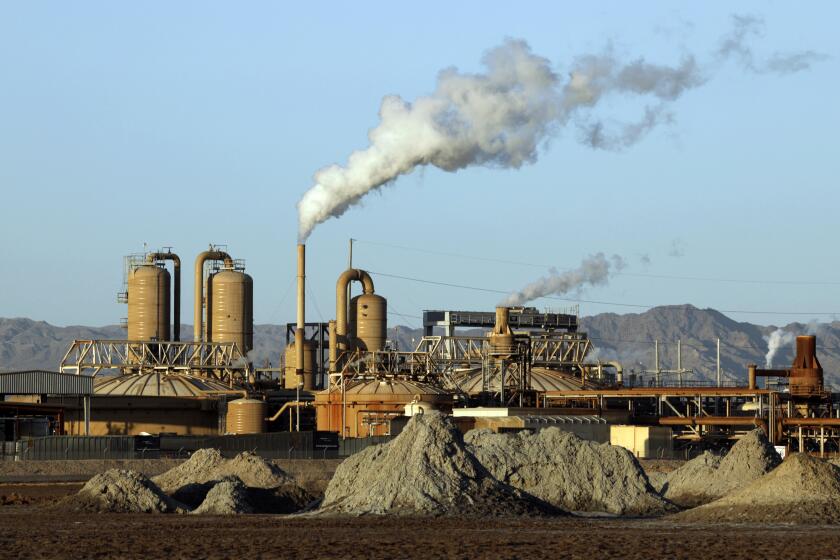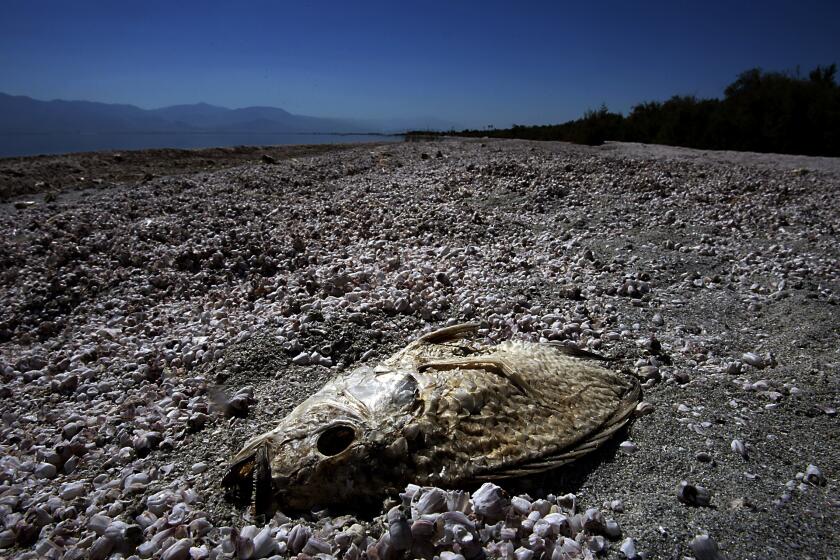Opinion: Imperial County residents deserve to benefit from a potential lithium boom

Imperial County consistently ranks among the most economically distressed places in California. Its Salton Sea, the state’s biggest and most toxic lake, is an environmental disaster.
The county also happens to be sitting on enough lithium to produce nearly 400 million batteries, sufficient to completely shift America’s auto industry to electric — and, if officials manage this moment carefully, to revolutionize the local economy and political culture.
This doesn’t need to come at the expense of the environment; companies are pioneering a method to extract the mineral from underground briny water and inject the water back into the ground in a closed loop, yielding the cleanest, greenest lithium on the planet.
A geothermal energy and lithium extraction plant is starting construction in the Imperial Valley.
It’s understandable why the prospect of a new clean industry, a “white gold rush,” would be appealing to residents. Capitalizing on the resource is not simple, however. If industry is allowed to drive the process completely, the result could be further economic and environmental exploitation. There’s a better way forward, though — an opportunity to ensure that residents directly benefit from the lithium extraction boom, while supporting the global shift to clean energy and ensuring that companies that invest in the Imperial Valley can turn a profit.
This pocket of California is emblematic of the potential and the risks that have long faced impoverished communities in resource-rich regions.
As often happens, public officials have been working to roll out the red carpet for big investors, including trying to create a clear plan for infrastructure and a quicker permitting process. To get community groups’ support, they are playing up the potential for jobs, including company commitments to hire local workers.
The rotting, polluted lake is poisoning residents and wildlife. Interest in the lithium deposits under the Salton Sea could bring attention to the environmental crisis.
But Imperial Valley residents, who have been on the receiving end of get-rich schemes around water and real estate in the past, are worried that their political leaders may be giving away the store.
Decades of racial exclusion and broken promises have led to a deep distrust of outsiders who assert that things will be better this time.
Irrigation at the turn of the last century was supposed to bring an agriculture boom, but the early result was a broken canal that released enough water over nearly two years of disrepair to create what is now the Salton Sea. The Salton Sea was then supposed to fuel tourism, but the failure to replenish it with anything but agricultural runoff helped kill fish, birds and recreation. In recent decades, a plan to attract solar farms delivered little employment and more worries about agricultural displacement.
A lithium boom could be different, but there is cause for caution.
California’s largest lake is shrinking. It can’t be refilled, but it can be saved.
Today’s battery technology — necessary for electric vehicles and energy storage — relies on minerals including cobalt, magnesium, nickel and graphite. And mineral extraction is often accompanied by obscured environmental risks. In Imperial Valley, environmental and community organizations are worried about lithium extraction’s water use as well as waste and air pollution as production steps up and truck traffic increases. The region’s childhood asthma rate is already more than twice the national average and dust from the drying lake is toxic, so any extra environmental health risk is a big deal.
Local communities are also concerned about how much benefit they will see while the industry profits. They note that the electric vehicle boom driving lithium demand occurred precisely because of public policy. Tesla, for example, has benefited from multiple rounds of state and federal zero-emissions-vehicle incentives, including the sale of emissions credits that accounted for 85% of Tesla’s gross margin in 2009 and rose to $1.8 billion a year by 2023.
Behind these policies and financial incentives have been public will and taxpayer money.
Imperial Valley residents, not just companies, deserve a return. Rather than promising to only pay for community “benefits,” such as environmental mitigation, contributions to municipal coffers or jobs, the companies extracting lithium could make payments directly to the people and communities that live there.
There are models for this type of approach. The Alaska Permanent Fund, for example, gives an annual amount to all state residents from oil extraction revenue.
Ensuring that the surrounding communities benefit from a new lithium boom also requires thinking about how to attract not just the companies extracting the lithium but those that will use it further down the supply chain — and generate more and better jobs. So far, Imperial County has had limited success in attracting related industries. Last year, a company said it would build a “gigafactory” there to assemble batteries. However, the company’s previous efforts in the United Kingdom and Italy have stalled.
A potentially promising future for modern transportation and energy storage may be brewing in Imperial Valley. But getting to a brighter future will require remembering a lesson from the past: Community investments tend to be hard-won. Ensuring that everyone benefits is essential for achieving a more inclusive and sustainable future.
Manuel Pastor is a professor of sociology and director of the Equity Research Institute at USC. Chris Benner is a professor and the director of the Institute for Social Transformation at UC Santa Cruz. They are co-authors of “Charging Forward: Lithium Valley, Electric Vehicles and a Just Future.” This article was produced in partnership with the Conversation.
More to Read
A cure for the common opinion
Get thought-provoking perspectives with our weekly newsletter.
You may occasionally receive promotional content from the Los Angeles Times.













